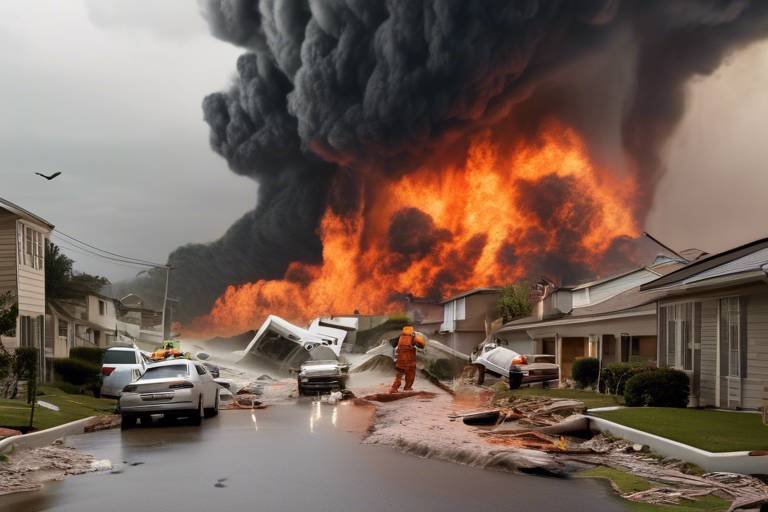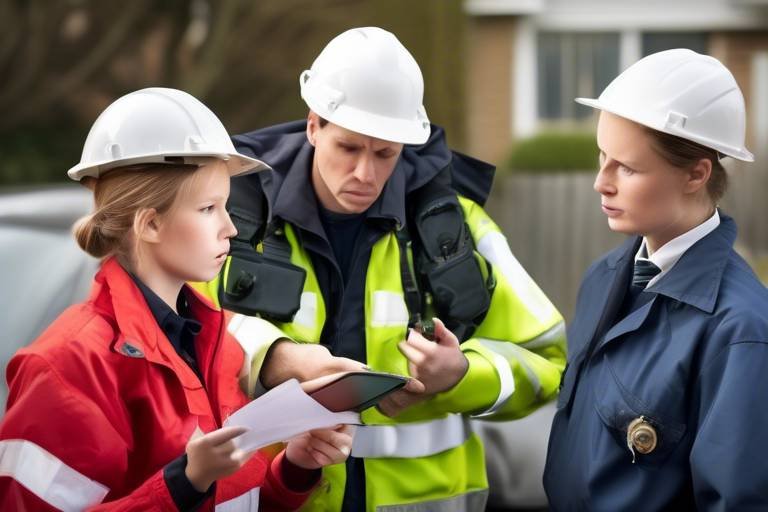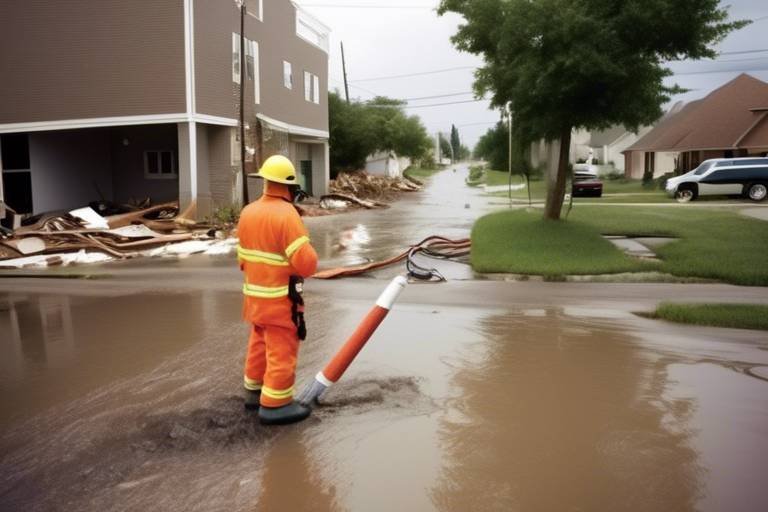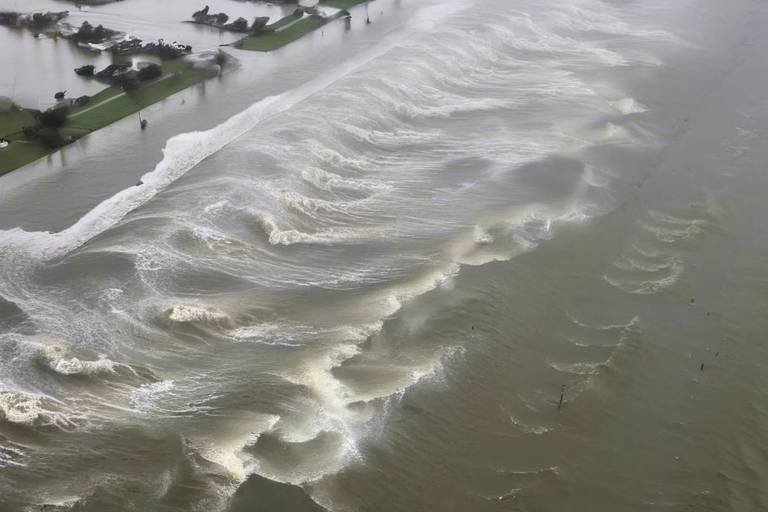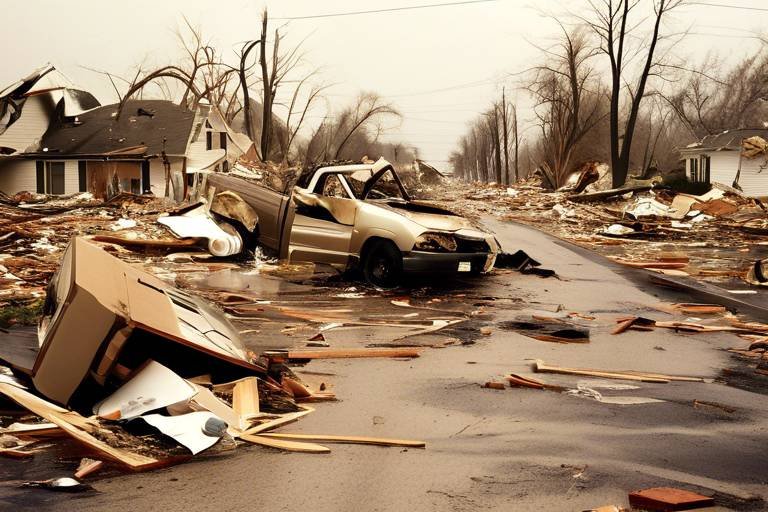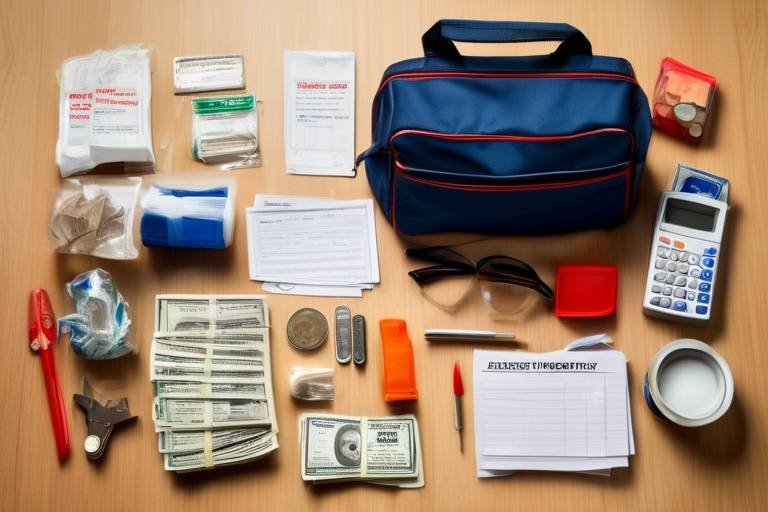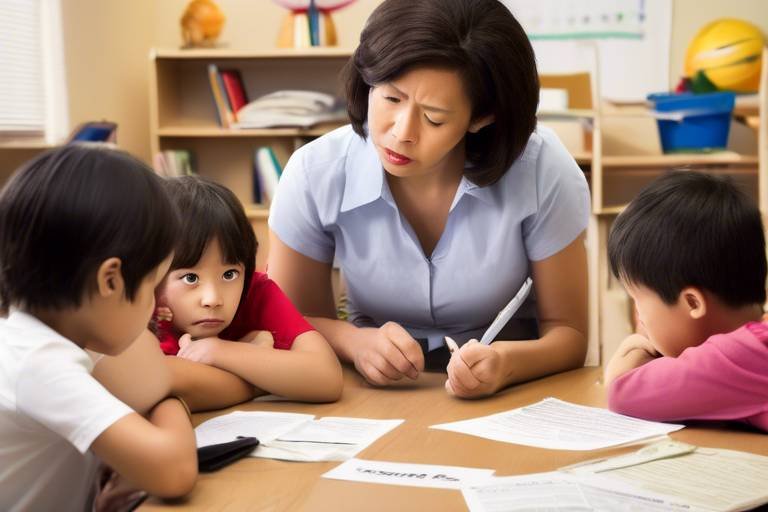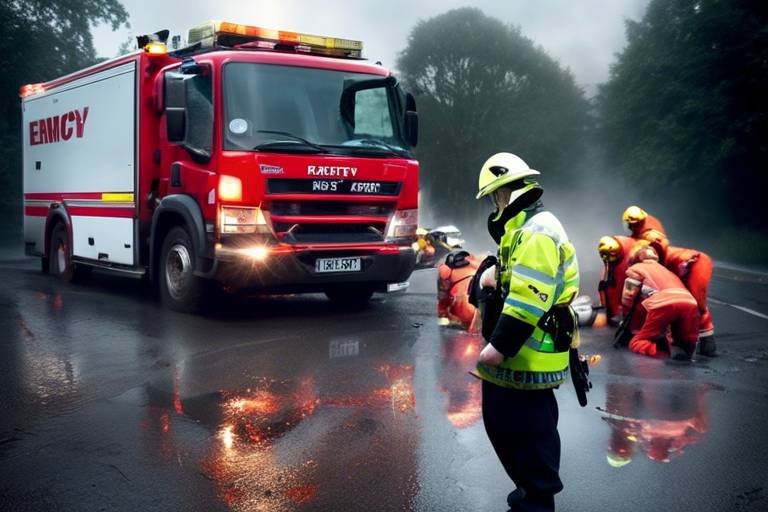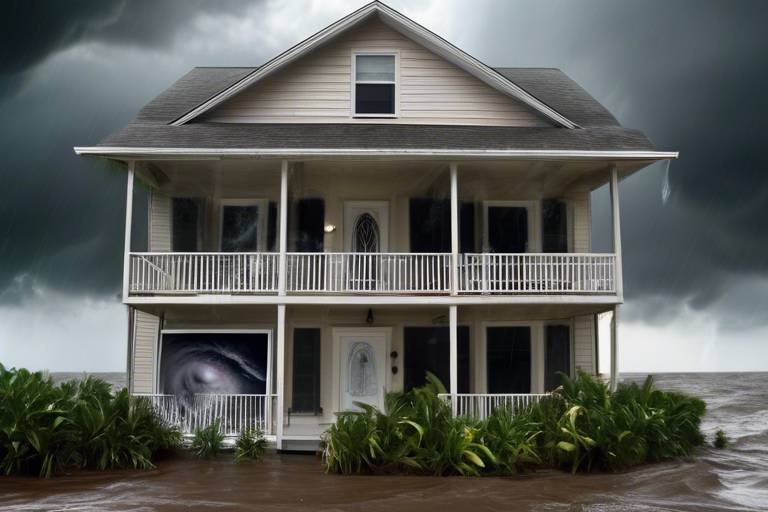How to Mitigate Risks and Hazards in a Disaster Scenario
This article explores effective strategies and practices to minimize risks and hazards during disaster scenarios, ensuring safety and preparedness for individuals and communities alike.
Identifying and understanding the various types of disaster risks is crucial for effective mitigation. Disasters can be broadly categorized into two main types: natural hazards and man-made hazards. Natural hazards include events like earthquakes, floods, hurricanes, and wildfires, which can strike suddenly and with devastating force. On the other hand, man-made hazards arise from human actions, such as industrial accidents, chemical spills, and terrorist attacks. Each of these risks presents unique challenges and requires tailored strategies to address them effectively.
Conducting thorough risk assessments allows communities to prioritize vulnerabilities and allocate resources effectively. This process involves identifying potential hazards, assessing the likelihood of their occurrence, and evaluating their potential impacts. Various techniques and tools are utilized to evaluate risks in disaster scenarios, ensuring that communities can prepare adequately.
Qualitative risk assessment focuses on subjective evaluation of risks based on experiences and expert opinions. This method is essential for understanding potential impacts and prioritizing actions. For instance, community members can share their experiences during past disasters, providing valuable insights into what went wrong and how similar events can be better managed in the future.
Utilizing focus groups can provide valuable insights into community perceptions of risks. This approach fosters dialogue and helps identify specific hazards that residents are concerned about. By engaging with community members, disaster management professionals can gain a deeper understanding of local fears and priorities, which can inform more effective planning and response strategies.
Engaging with experts in disaster management can enhance the quality of risk assessments. Their knowledge aids in identifying less obvious hazards that may not be immediately apparent. Experts can offer data-driven insights and best practices that communities can adopt, ensuring a comprehensive understanding of potential risks and effective mitigation strategies.
Quantitative risk assessment employs statistical methods to analyze data and predict potential impacts. This section highlights the importance of data-driven approaches in disaster preparedness. By utilizing historical data and predictive analytics, communities can create models that forecast the likelihood of various disaster scenarios, helping them to prioritize their preparedness efforts.
Creating a comprehensive disaster preparedness plan is vital for effective risk mitigation. An effective plan outlines the steps that need to be taken before, during, and after a disaster. Key components of an effective plan include communication strategies, resource allocation, and training for community members to ensure everyone knows their roles in a crisis.
Effective communication is critical during disasters. Establishing reliable communication protocols ensures timely information dissemination to all stakeholders. This can include setting up emergency hotlines, utilizing social media platforms for real-time updates, and conducting regular drills to familiarize everyone with the communication channels. Remember, during a disaster, clear communication can save lives.
Efficient resource management can significantly reduce the impact of disasters. Effective strategies for inventory management, logistics, and ensuring the availability of essential supplies are crucial. Communities should regularly assess their resource needs and establish partnerships with local organizations to streamline the distribution of supplies during emergencies. This proactive approach can make a world of difference when a disaster strikes.
- What are the first steps in disaster preparedness? Start by assessing your risks, creating an emergency plan, and gathering supplies.
- How can communities stay informed about disaster risks? Communities can stay informed through local government updates, community meetings, and educational workshops.
- What role do volunteers play in disaster scenarios? Volunteers can assist in emergency response efforts, provide support to affected individuals, and help with recovery efforts.

Understanding Disaster Risks
Understanding disaster risks is the first step towards effective mitigation. It’s like knowing the storm is coming before it hits; that awareness can make all the difference. Disasters can be broadly categorized into two types: natural hazards and man-made hazards. Each type presents unique challenges and requires tailored strategies for risk reduction.
Natural hazards include events such as earthquakes, floods, hurricanes, and wildfires. These are often unpredictable and can cause extensive damage to both life and property. For instance, consider a hurricane that suddenly shifts course, catching communities off guard. The devastation can be immense, leading to loss of homes, livelihoods, and even lives. Understanding the geographical and climatic factors that contribute to these events is crucial for preparedness.
On the other hand, man-made hazards arise from human actions or negligence. These include industrial accidents, chemical spills, and acts of terrorism. For example, a factory explosion can have catastrophic effects on surrounding neighborhoods, highlighting the importance of safety regulations and emergency response plans. The key here is awareness; recognizing that our actions can lead to disasters is vital for prevention.
To better illustrate the differences between these types of hazards, consider the following table:
| Type of Hazard | Examples | Potential Impact |
|---|---|---|
| Natural Hazards | Earthquakes, Floods, Hurricanes, Wildfires | Loss of life, Property damage, Displacement |
| Man-Made Hazards | Industrial Accidents, Chemical Spills, Terrorism | Injury, Environmental damage, Economic loss |
By identifying these risks, communities can take proactive measures to mitigate their effects. It’s not just about reacting to disasters; it’s about anticipating them and preparing accordingly. This can involve community education, infrastructure improvements, and the establishment of emergency response teams. After all, wouldn’t you rather be prepared than caught off guard?
In conclusion, understanding disaster risks is essential for building resilient communities. It empowers individuals and organizations to take action, ensuring that when disaster strikes, they are ready to respond effectively. Remember, knowledge is power. The more we understand about the risks we face, the better equipped we will be to handle them.

Risk Assessment Techniques
Conducting thorough risk assessments is the cornerstone of effective disaster preparedness. These assessments help communities identify vulnerabilities and prioritize actions to mitigate potential hazards. When it comes to risk assessment, there are two main approaches: qualitative and quantitative. Each method has its strengths and can be chosen based on the specific needs of a community.
Qualitative risk assessment focuses on subjective evaluations of risks, drawing from experiences and expert opinions. This method is particularly useful for understanding the potential impacts of various hazards. By relying on narratives and insights from community members, qualitative assessments can paint a vivid picture of the risks faced. For instance, local residents might express concerns about flooding based on past experiences, which can guide future planning.
One effective way to gather qualitative data is through focus group discussions. These sessions bring together community members to discuss their perceptions of risks, fostering an environment of dialogue. In these discussions, participants can share personal stories, concerns, and suggestions, which can reveal specific hazards that may not be immediately apparent to external evaluators. For example, a focus group might highlight the fear of landslides in a hilly area, prompting further investigation and mitigation efforts.
Engaging with experts in disaster management can significantly enhance the quality of risk assessments. Experts can provide insights into less obvious hazards and share knowledge about best practices in risk mitigation. For instance, a disaster management consultant might highlight the importance of assessing structural vulnerabilities in buildings, which could be overlooked by community members. Their expertise can lead to a more comprehensive understanding of the risks at hand.
On the other hand, quantitative risk assessment employs statistical methods to analyze data and predict potential impacts. This approach is crucial for communities that want to base their preparedness plans on solid evidence. By using historical data, probability models, and simulations, communities can estimate the likelihood of various disasters and their potential impacts. For example, a city might use past flood data to predict future flooding events, allowing them to allocate resources effectively.
To illustrate the differences between qualitative and quantitative assessments, consider the following table:
| Aspect | Qualitative Assessment | Quantitative Assessment |
|---|---|---|
| Data Source | Community input, expert opinions | Statistical data, historical records |
| Focus | Subjective understanding of risks | Objective measurement and prediction |
| Outcome | Insights and narratives | Numerical estimates and probabilities |
Both qualitative and quantitative assessments are vital for a comprehensive understanding of disaster risks. By combining these approaches, communities can develop a more nuanced view of their vulnerabilities, leading to better preparedness strategies.
In conclusion, effective risk assessment techniques are essential for identifying hazards and preparing for disasters. Whether through qualitative discussions that capture community sentiments or quantitative analyses that provide hard data, both methods play a critical role in ensuring safety and resilience. By investing time and resources into these assessments, communities can significantly enhance their disaster preparedness efforts.
- What is the difference between qualitative and quantitative risk assessments? Qualitative assessments focus on subjective evaluations based on community insights, while quantitative assessments use statistical data to predict risks.
- How can focus groups improve risk assessments? Focus groups provide valuable community perspectives, revealing specific concerns and risks that may not be recognized by external evaluators.
- Why is expert consultation important in risk assessment? Experts bring specialized knowledge and experience, helping to identify less obvious hazards and recommending best practices for mitigation.

Qualitative Risk Assessment
In the realm of disaster management, serves as a vital tool that emphasizes the subjective evaluation of risks based on personal experiences and expert opinions. Unlike its quantitative counterpart, which relies heavily on numerical data and statistical analysis, qualitative assessment dives deep into the narratives and perceptions that shape our understanding of potential hazards. Imagine walking through a community where every resident has a story to tell about a past disaster—these stories are not just anecdotes; they provide invaluable insights into the community's vulnerabilities and resilience.
One of the most effective ways to gather these insights is through focus group discussions. By bringing together diverse groups of individuals, we can foster an environment of open dialogue where community members feel safe to express their concerns and share their experiences. These discussions can uncover specific hazards that may not be immediately obvious to outsiders, such as localized flooding patterns or the psychological impacts of previous disasters. It's like piecing together a puzzle; each person's contribution helps complete the picture of risk within the community.
Moreover, engaging with experts in the field of disaster management enhances the quality of qualitative assessments. These professionals possess a wealth of knowledge that can illuminate less apparent risks. For instance, while a community may be aware of the dangers posed by hurricanes, an expert might highlight the potential for secondary impacts, such as contamination of water supplies or the long-term economic effects of evacuation. This blend of community insights and expert analysis creates a comprehensive understanding of risks that can inform mitigation strategies.
In summary, qualitative risk assessment is not just about identifying what could go wrong; it’s about understanding the human element behind those risks. By valuing personal experiences and expert opinions, communities can prioritize their actions effectively, ensuring that their disaster preparedness plans are not only data-driven but also resonate with the realities faced by those who live there. Ultimately, this holistic approach to risk assessment lays the groundwork for a more resilient community, one that is better equipped to face the challenges of future disasters.
- What is qualitative risk assessment?
Qualitative risk assessment focuses on subjective evaluations of risks based on experiences and expert opinions, helping to identify potential impacts and prioritize actions.
- Why are focus group discussions important?
Focus group discussions provide valuable insights into community perceptions of risks, fostering dialogue and identifying specific hazards of concern.
- How do experts contribute to qualitative assessments?
Experts enhance qualitative assessments by identifying less obvious hazards and providing a deeper understanding of potential impacts based on their knowledge and experience.

Focus Group Discussions
Focus group discussions are an incredibly effective way to tap into the collective wisdom of a community when it comes to understanding disaster risks. Imagine sitting in a room filled with individuals who have experienced various disasters firsthand; their stories, insights, and feelings can paint a vivid picture of the potential hazards that might not be evident through data alone. In these discussions, participants share their personal experiences, concerns, and suggestions, which can help identify specific risks that may be overlooked in traditional assessments.
The beauty of focus groups lies in their ability to foster open dialogue. By creating a safe space for community members to express their thoughts, we can uncover a wealth of information about local vulnerabilities. For instance, one participant might share their fear of flooding due to the nearby river, while another might discuss the lack of emergency services in their area. Such insights are invaluable for developing targeted mitigation strategies.
Moreover, focus group discussions can also help in building **community resilience**. When individuals come together to discuss their concerns, they often find common ground, which can lead to collaborative efforts in preparing for disasters. This sense of unity not only strengthens community bonds but also enhances the overall preparedness of the area.
To ensure that these discussions are effective, it is important to consider the following elements:
- Facilitator Role: A skilled facilitator can guide the conversation, encourage participation, and keep the discussion focused on relevant topics.
- Diverse Representation: Including a diverse group of participants ensures that various perspectives and experiences are represented, leading to a more comprehensive understanding of community risks.
- Follow-Up: After the discussions, it’s essential to summarize the findings and share them with the participants. This not only validates their input but also keeps them engaged in the process.
In conclusion, focus group discussions are a powerful tool for uncovering the hidden risks that communities face in disaster scenarios. By leveraging the knowledge and experiences of residents, we can create more effective and tailored disaster preparedness plans that resonate with the specific needs of the community. So, the next time you think about disaster risk assessment, remember that the voices of the people are just as crucial as the data on paper.

Expert Consultations
Engaging with experts in disaster management is a cornerstone of effective risk assessment. These professionals bring a wealth of knowledge and experience that can significantly enhance the quality of evaluations conducted within a community. When you consult with an expert, you’re not just getting a second opinion; you’re tapping into specialized insights that might not be immediately apparent to those without a background in disaster preparedness. Think of it like bringing in a seasoned coach to guide a sports team—sometimes, an outsider's perspective can uncover weaknesses and strengths that the team itself might overlook.
Experts can help identify less obvious hazards that may be lurking beneath the surface. For instance, while the community may be aware of flood risks, an expert might highlight vulnerabilities related to infrastructure, such as outdated drainage systems or the potential for landslides in certain areas. This kind of comprehensive analysis is essential for developing a well-rounded disaster preparedness strategy.
Moreover, expert consultations can also facilitate the development of tailored approaches to risk mitigation. Depending on the specific needs of a community, experts can recommend targeted training sessions, workshops, or simulations that address identified risks. For example, a community prone to earthquakes may benefit from specialized drills that teach residents how to respond effectively during such an event. These tailored strategies ensure that everyone is not only aware of the risks but also prepared to take action when the time comes.
To maximize the benefits of expert consultations, consider the following steps:
- Identify Relevant Experts: Look for professionals with experience in the specific types of disasters that your community faces. This can include meteorologists, structural engineers, or public health officials.
- Schedule Regular Consultations: Make expert consultations a routine part of your community’s disaster preparedness efforts. Regular check-ins can help keep risk assessments up-to-date.
- Encourage Community Involvement: Involve community members in discussions with experts. This not only fosters a sense of ownership but also encourages dialogue that can lead to more comprehensive risk assessments.
In conclusion, expert consultations are not just an optional add-on; they are a vital component of a proactive approach to disaster risk management. By leveraging the insights and expertise of professionals, communities can significantly enhance their preparedness and resilience, ensuring that they are not only ready to respond to disasters but can also recover and thrive in their aftermath.
Q: How do I find disaster management experts in my area?
A: You can start by contacting local universities, government agencies, or non-profit organizations that specialize in disaster preparedness and response. Networking at community events can also help you connect with professionals in the field.
Q: What types of experts should I consult for a comprehensive risk assessment?
A: It's beneficial to consult a range of experts, including environmental scientists, engineers, public health officials, and emergency management professionals. Each brings a unique perspective that can enhance your understanding of risks.
Q: How often should we consult with experts?
A: Ideally, expert consultations should be scheduled regularly, at least once a year, or whenever there are significant changes in community demographics, infrastructure, or environmental conditions.

Quantitative Risk Assessment
When it comes to preparing for disasters, stands out as a powerful tool. Unlike its qualitative counterpart, which relies on subjective evaluations, quantitative risk assessment dives deep into the numbers. It employs statistical methods to analyze data, allowing communities to predict potential impacts with a level of precision that can be crucial in emergency situations. Imagine trying to navigate through a storm without a weather forecast; that’s how it feels to approach disaster preparedness without a quantitative assessment. By using data-driven approaches, communities can make informed decisions that ultimately save lives and resources.
One of the key benefits of quantitative risk assessment is its ability to highlight the likelihood of various risks occurring. For instance, consider a coastal town that faces threats from hurricanes. By analyzing past hurricane data, the town can estimate the probability of future storms and their potential severity. This not only helps in preparing for the worst but also in allocating resources effectively. For example, if the data indicates a high likelihood of a category 4 hurricane, the town can prioritize strengthening infrastructure, stockpiling emergency supplies, and conducting community drills.
Quantitative assessments often involve sophisticated models and simulations that take into account various factors such as population density, geographical features, and historical data. These models can generate valuable insights, such as:
- The expected number of people affected in different disaster scenarios.
- The economic impact of potential disasters on local businesses and infrastructure.
- Resource needs for effective response and recovery efforts.
However, it’s not just about crunching numbers. The effectiveness of quantitative risk assessment hinges on the quality of the data being used. Communities must ensure they are working with up-to-date and comprehensive datasets. Collaborating with local universities, research institutions, and government agencies can provide access to valuable information. Additionally, incorporating community feedback can help fine-tune the data, making it even more relevant to local contexts.
To illustrate the impact of quantitative risk assessment, let’s take a look at a hypothetical scenario:
| Disaster Type | Probability of Occurrence (%) | Potential Impact ($) |
|---|---|---|
| Flood | 30 | 1,000,000 |
| Earthquake | 10 | 5,000,000 |
| Hurricane | 20 | 3,000,000 |
In this table, we can see the estimated probabilities and potential impacts of different disasters. By quantifying these risks, the community can prioritize their preparedness efforts based on which disasters pose the greatest threat. For instance, despite the flood having a higher probability of occurrence, the earthquake’s potential impact is significantly greater. This insight allows for strategic planning and resource allocation, ensuring that the most pressing risks are addressed first.
In conclusion, quantitative risk assessment is an invaluable component of disaster preparedness. It transforms abstract fears into concrete data, enabling communities to make informed decisions. By embracing this approach, we can build resilience and ensure that when disaster strikes, we are not caught off guard but rather ready to respond effectively.
Q: What is the main difference between qualitative and quantitative risk assessments?
A: The main difference lies in their approach: qualitative assessments rely on subjective evaluations and expert opinions, while quantitative assessments use statistical data and models to predict risks and impacts.
Q: How can communities collect data for quantitative risk assessments?
A: Communities can gather data through various means, including collaboration with local universities, government agencies, and utilizing existing databases that track historical disaster events.
Q: Why is it important to update data regularly for risk assessments?
A: Regular updates ensure that the data reflects current conditions, trends, and vulnerabilities, allowing for more accurate predictions and effective preparedness strategies.

Developing a Disaster Preparedness Plan
Creating a comprehensive disaster preparedness plan is not just a good idea; it's a necessity. Imagine waking up one day to find your community facing a natural disaster, like a hurricane or an earthquake. The chaos can be overwhelming, but having a solid plan can make all the difference. A well-structured plan helps ensure that you and your loved ones know what to do when the unexpected strikes. So, what should be included in this plan? Let's dive in!
First and foremost, your plan should address communication strategies. During a disaster, clear and timely communication can save lives. Establishing reliable communication protocols is essential. This means identifying how information will be shared among family members, neighbors, and local authorities. Consider creating a communication tree, where everyone knows who to contact and how to reach them. This could involve setting up a group chat or designating a meeting point where everyone can gather if phone lines go down.
Next, we need to talk about resource management. Efficiently managing resources can significantly reduce the impact of disasters. This involves not only having supplies on hand but also knowing how to utilize them effectively. Start by creating an inventory of essential supplies, such as food, water, medications, and first aid kits. Understanding how to access these resources quickly can be a lifesaver in critical situations. For instance, if a flood occurs, knowing where your emergency supplies are stored can save you precious time.
| Essential Supplies | Quantity | Notes |
|---|---|---|
| Water (1 gallon per person per day) | 3 days supply | Store in a cool, dry place |
| Non-perishable food | 3 days supply | Canned goods, energy bars, etc. |
| First Aid Kit | 1 | Include personal medications |
| Flashlights | 2 | With extra batteries |
Another critical aspect of your disaster preparedness plan is evacuation routes. Knowing how to get out of your area safely is paramount. Map out several routes in advance, taking into consideration potential road closures and traffic patterns. Share these routes with your family and practice them if possible. This way, when the time comes, everyone will know exactly where to go and how to get there.
Lastly, don't forget to include training and drills in your plan. It’s one thing to have a plan written down, but it’s another to practice it. Conduct regular drills with your family to ensure everyone knows their roles and responsibilities. This not only builds confidence but also helps identify any gaps in your plan that need to be addressed. Remember, practice makes perfect! The more prepared you are, the less chaotic the situation will be.
In summary, developing a disaster preparedness plan involves a multi-faceted approach that includes effective communication, resource management, clear evacuation routes, and regular training. By taking the time to create and practice your plan, you’re not just ensuring your safety; you’re also empowering your community to respond effectively in times of crisis. So, are you ready to take that first step toward preparedness?
- What should I include in my emergency kit? Your kit should contain water, non-perishable food, a first aid kit, flashlights, batteries, and important documents.
- How often should I review my disaster plan? It's a good idea to review and update your plan at least once a year or whenever there's a significant change in your household.
- What is the best way to communicate during a disaster? Establish a communication plan that includes multiple methods such as text messaging, social media, and a designated meeting place.

Establishing Communication Protocols
When disaster strikes, effective communication can mean the difference between chaos and order. Establishing robust communication protocols is essential for ensuring that information flows smoothly among all stakeholders, including emergency responders, local authorities, and the community. Imagine a ship lost at sea; without a reliable communication system, the crew would struggle to navigate and coordinate rescue efforts. In the same way, communities need a clear communication strategy to guide them through turbulent times.
To create an efficient communication protocol, it’s crucial to identify the various channels and tools available. This can include traditional methods like radio broadcasts and community bulletin boards, as well as modern technologies such as social media platforms and mobile apps. Each method has its own strengths and weaknesses, so it’s important to consider the demographics of your community. For instance, older residents may rely more on radio announcements, while younger individuals might be more engaged through social media updates.
Furthermore, establishing a hierarchical communication structure can streamline the process. This means designating specific individuals or teams responsible for relaying information to various groups. For example, emergency coordinators can be tasked with disseminating critical updates to local shelters, while community leaders can keep residents informed through neighborhood meetings. By having a clear chain of command, you minimize the risk of misinformation and ensure that everyone receives timely updates.
Another key aspect is ensuring that communication protocols are inclusive and accessible. This means providing information in multiple languages and formats, catering to individuals with disabilities, and ensuring that all community members have access to crucial updates. Consider the use of visual aids such as infographics or videos that can simplify complex information. Moreover, conducting regular drills can help familiarize everyone with communication procedures, making it easier to implement them during an actual disaster.
Finally, evaluating and updating communication protocols regularly is essential. After each drill or actual event, gather feedback from participants to identify areas for improvement. This iterative process will help refine your communication strategies and ensure they remain effective in the face of evolving risks. Remember, communication is not just about sending messages; it’s about ensuring that those messages are understood and acted upon.
- What types of communication channels should be included in a disaster plan?
It's important to incorporate a mix of traditional and modern channels, including radio, social media, text alerts, and community meetings to reach all demographics. - How can I ensure my communication protocols are accessible?
Provide information in multiple languages and formats, and consider the needs of individuals with disabilities to ensure everyone can access crucial updates. - Why is it important to have a hierarchical communication structure?
A hierarchical structure streamlines information flow, reduces the risk of misinformation, and ensures timely updates are communicated to the right people. - How often should communication protocols be reviewed?
Regular evaluations after drills or real events help identify areas for improvement, ensuring that protocols remain effective over time.

Resource Management Strategies
When it comes to disaster preparedness, resource management is your best friend. Think of it as the backbone of your disaster response plan. Without proper resources, even the most well-crafted plans can fall flat. So, how do we ensure that our resources are managed effectively? It starts with understanding the types of resources we need and how to allocate them efficiently.
First off, let's talk about inventory management. It's crucial to have a comprehensive list of all available resources, whether they are food supplies, medical equipment, or emergency tools. By maintaining an up-to-date inventory, communities can quickly assess what they have on hand and what they might need to acquire. Imagine trying to bake a cake without knowing if you have flour or sugar—chaos, right? Similarly, without a clear inventory, your disaster response could easily become disorganized.
Next, consider logistics. This is where the magic happens. Logistics involves the planning and execution of moving resources from one place to another, ensuring that they arrive where they are needed when they are needed. Picture a well-oiled machine; each part must work together seamlessly to achieve the desired outcome. In disaster scenarios, this means having a reliable transportation plan in place. Will you use trucks, boats, or even drones? The choice depends on the situation, but the goal remains the same: to ensure that resources are delivered swiftly and efficiently.
Another important aspect is ensuring the availability of essential supplies. This includes food, water, medical supplies, and shelter materials. Communities should establish partnerships with local suppliers and organizations to create a robust supply chain. By building these relationships ahead of time, you can avoid the panic and shortages that often accompany disasters. It's like having a safety net; you may not need it all the time, but when you do, you’ll be glad it’s there!
To further enhance resource management, communities can implement a resource allocation strategy. This involves prioritizing resources based on the needs of the situation. For instance, during a flood, water and food might take precedence over other supplies. By assessing the situation and adjusting resource allocation accordingly, communities can respond more effectively. A table can help visualize this process:
| Resource | Priority Level | Reason for Priority |
|---|---|---|
| Water | High | Essential for survival |
| Medical Supplies | High | Injuries may occur |
| Food | Medium | Necessary for sustained energy |
| Shelter Materials | Medium | Protection from elements |
Finally, don’t forget about training and drills. Regularly practicing your resource management plan can make a world of difference when disaster strikes. It’s like rehearsing for a play; the more you practice, the more confident you become in your role. Encourage community members to participate in these drills so everyone knows their responsibilities and can act swiftly and efficiently when the time comes.
In conclusion, effective resource management strategies can significantly reduce the impact of disasters. By focusing on inventory management, logistics, essential supplies, and training, communities can enhance their preparedness and response capabilities. Remember, in the face of disaster, being proactive is the key to survival!
- What is the first step in resource management for disasters?
Identify and catalog all available resources to understand what you have on hand. - How can communities improve their logistics?
Establish reliable transportation methods and maintain partnerships with local suppliers. - Why is training important in resource management?
Regular training ensures that everyone knows their roles and can act quickly during a disaster.
Frequently Asked Questions
- What are the common types of disaster risks?
Disaster risks can be broadly categorized into natural and man-made hazards. Natural hazards include events like earthquakes, floods, hurricanes, and wildfires, while man-made hazards encompass industrial accidents, terrorism, and environmental pollution. Understanding these risks is essential for effective mitigation strategies.
- How can I conduct a risk assessment for my community?
Conducting a risk assessment involves both qualitative and quantitative techniques. You can start by gathering community input through focus group discussions to understand local perceptions of risks. Additionally, employing statistical methods to analyze data can help predict potential impacts, making your assessment more robust and actionable.
- What should be included in a disaster preparedness plan?
A comprehensive disaster preparedness plan should include several key components: clear communication protocols, resource management strategies, and emergency response procedures. It's crucial to ensure that all stakeholders are aware of their roles and responsibilities during a disaster to enhance overall community resilience.
- Why is effective communication important during disasters?
Effective communication during disasters is vital for ensuring that timely and accurate information reaches everyone involved. It helps coordinate response efforts, reduces panic, and ensures that individuals know what actions to take for their safety. Establishing reliable communication protocols ahead of time can make a significant difference in crisis situations.
- How can I manage resources effectively during a disaster?
Efficient resource management involves keeping an accurate inventory of supplies, planning logistics for distribution, and ensuring that essential items are readily available. Developing partnerships with local organizations can also enhance resource sharing and improve overall preparedness.

